SETON HILL: CENTRAL CITY'S GREENEST NEIGHBORHOOD
(BUT MOST PEOPLE DON'T KNOW IT.)
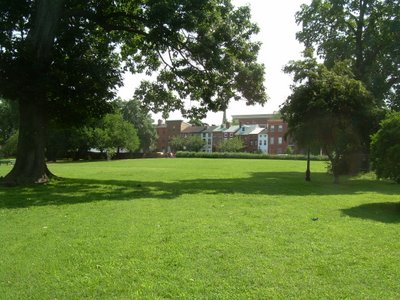
Aren't you getting tired of various things being declared "Baltimore's best kept secret"? They're not secrets, they're ignorance. It's an act of pathetic desperation when ignorance is declared a virtue in the name of reverse psychology, or some kind of fake snob appeal exclusivity, or out of some strange fear that publicizing goodness will ruin it.
Take Seton Hill. It is a fantastic neighborhood, built around a huge park that most people would (figuratively) die for. It's closer to downtown than most of Fells Point and Federal Hill, and there's no physical reason why it should be perceived separately from Mount Vernon.
Most of the houses are small and manageable enough to suit modern needs, but there are a few Victorian monsters for those who are into that sort of thing. After all, why should suburban McMansion mavens have all the fun?
The iconic view of Seton Hill should be something resembling the photo above - viewing the huge grassy St. Mary's Park under mature shade trees in the foreground, and lovely nineteenth century rowhouses in the background. But who gets to take in this gorgeous view? Hardly anyone, even though it is totally public.
Even people who live in Seton Hill have to work to get that view even though it is at the center of the neighborhood. The park has a wall and hedges surrounding it, cutting it off from casual contact. There are openings in the perimeter, and ritual joggers and dog walkers can plan their day around that, but such choreographed activity is hardly casual.
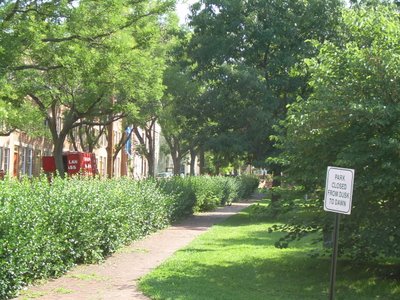
There are bad rituals that lead folks to the park as well as good ones. The City has concluded that the bad ones are more likely to take place at night. So the park entrances are posted: "Park Closed From Dusk to Dawn" (picture above). It is deemed better to close up the park completely half the time than to accommodate these bad people.
The traffic patterns in Seton Hill are truly bizarre. There is very little possible neighborhood vehicular circulation. One must plan one's entry route to the neighborhood based on where on wishes to attempt to park. If one wishes to try to park on the long block of Paca Street adjacent to the park (shown in Picture 1), it is advisable to enter the neighborhood from the south from Franklin Street, even if you're actually coming from the north. If you want to park on Orchard or St. Mary, you pretty much have to enter the neighborhood on Druid Hill Avenue via MLK Boulevard from the north, even if you are actually coming from the south.
This does not mean that Seton Hill is sheltered from heavy through traffic. Quite the contrary. Paca is the heaviest northbound street on downtown's entire west side. Eutaw is the ONLY through street that serves southbound traffic between Cathedral/Maryland and Greene/Pennsylvania, a distance of five blocks or more. Which is particularly odd since all the other streets are one-way northbound while Eutaw is two-way and has only a single southbound thru lane. Druid Hill, McCulloh, Madison and Centre are also thru traffic conduits.
The circulation in the triangular portion of Seton Hill inside MLK Boulevard, Druid Hill Avenue and Eutaw Street defies description. Inside this "Bermuda Triangle" are by far the most disastrously designed intersections in the urban city. They were probably designed at the same time back in the '60's or so, and probably represent the nadir of urban traffic planning.
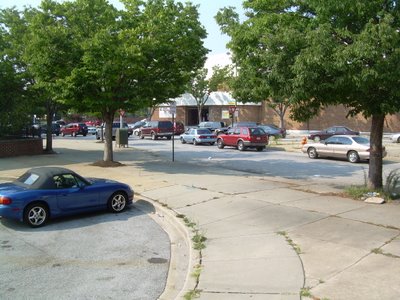 The intersection of McCulloh, Madison and Orchard is shown in the picture above. McCulloh has a very tight, sharp angled yield/ merge/ weave with Madison, which aside from being a disaster for pedestrians, is terrible for motor vehicles too because much of the traffic coming from Madison to the right wants to bear left into MLK, while much of the McCulloh traffic from the left wants to bear right to avoid the turn into MLK. The only way to make these quasi-expressway maneuvers work at all is to cut off Orchard Street altogether, so it has an ugly cul-de-sac, which leads to the circuitous circulation for which the explanation was previously attempted.
The intersection of McCulloh, Madison and Orchard is shown in the picture above. McCulloh has a very tight, sharp angled yield/ merge/ weave with Madison, which aside from being a disaster for pedestrians, is terrible for motor vehicles too because much of the traffic coming from Madison to the right wants to bear left into MLK, while much of the McCulloh traffic from the left wants to bear right to avoid the turn into MLK. The only way to make these quasi-expressway maneuvers work at all is to cut off Orchard Street altogether, so it has an ugly cul-de-sac, which leads to the circuitous circulation for which the explanation was previously attempted.
Orchard should be the street that provides the direct physical and emotional connection between Seton Hill and Mount Vernon, but because of the cul-de-sac and the extremely hostile intersection for pedestrians, this does not exist.
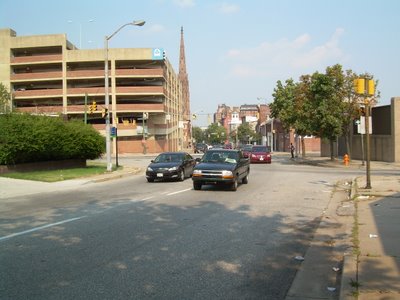
If anything, the intersection a short block away at Madison, Eutaw and Paca is even more bizarre. The picture above looks east on Madison Street, which is one-way westbound. Paca is just to the right. Most of the traffic on Paca wishes to proceed onto northbound Eutaw, which is to the left in front of the monster parking garage. The only way to do this is to engage in a slalom that requires turning right the wrong way on the one-way Madison for a short distance and then left onto Eutaw. This slalom involves two lanes of traffic, although during most hours there is only one lane on northbound Eutaw to accept this traffic. There are no warnings about the need to merge into one lane, and any attempt to provide such a warning would simply divert the motorists' attention away from the myriad other hazards, such as pedestrians and vehicles illegally turning right on red. Similarly, there is no warning on Madison about the traffic from Paca which suddenly appears going the wrong way down a one-way street.
To further confuse matters, the combined intersection of these streets is physically huge and unchannelized, with extremely large turning radii, especially for the right turn from Madison to Eutaw (which is prohibited on red.)
In sum, Seton Hill has the most schizophrenic traffic patterns in all of Baltimore.
The underlying blame for this condition can probably be traced to the fact that Seton Hill is located at the point of collision between the north-south street grid of downtown and the angled street grid of northwest Baltimore. Paca, Eutaw, Centre and Madison Streets represent the former, while St. Mary, Orchard, McCulloh and Druid Hill represent the latter.
But blaming Seton Hill's problems on a 19th century accident of geographical fate is the pinnacle of lame excuses, and merely illustrates just how ridiculous urban inertia (urbinertia?) can be. With regard to Seton Hill, the City needs to face the following:
1. St. Mary's Park needs to function like virtually all great urban parks - it needs to be at the center of EVERYTHING. It needs to function as a town square; as the central stage on which all the urban theater which is Seton Hill is played out.
2. Seton Hill needs to be integrated into adjacent Mount Vernon, which is currently experiencing a neighborhood renaissance simply because it has found its identity. Mount Vernon finally knows what it is and is acting accordingly to do something about it.
There is still a tendency to get hung up over geometric shapes and configurations. St. Mary's Park has spent most of its life not as a park but as the grounds of St. Mary's Seminary. Many Baltimore parks are not parks because they were planned that way from the beginning, but simply because they were bequeathed to the City by the landowners. Similarly, intersections need to function and it is sometimes difficult for traffic engineers to make intersections work if they are carrying traffic on more than two streets.
But enough with the excuses. Mount Vernon Square is called a square NOT because it is in the shape of a square (which it isn't), but because it is the central stage for Mount Vernon as a neighborhood. Here's what needs to be done:
1. A public street needs to be built through St. Mary's Park between St. Mary and Paca Street. That's right - right thru it. It will not carry much traffic and it can be very narrow, but it will make St. Mary's Park function as a true public space and it will orient that space to the neighborhood as a whole. Seton Hill residents will be able to use the street to circle around the neighborhood as they search for that holy grail of urban neighborhoods - a parking space. People who live on St. Mary and Orchard will finally thus finally feel a physical bond with people who live on Paca. Park dwellers will no longer be tempted to behave as if they are in a private space, but will feel like they are on the urban stage. This will feed the healthy need for urban neighborhoods to accommodate exhibitionists and their audience. Moreover, the police will be able to cruise around the neighborhood and watch the park denizens from their vehicles. There should thus no longer be a need to shut the park down at sundown.
2. The intersections on Madison Street at Eutaw/Paca and Orchard/McCulloh need to be reconfigured into normal urban intersections instead of weird satanic death traps. Madison Street needs to serve as the spine that unifies Mount Vernon and Seton Hill. To do this properly, the appropriate traffic functions need to be defined for Paca, Eutaw, McCulloh and Druid Hill. A proposal that was made for the Upton Master Plan (the neighborhood to the north) was to connect Paca to Madison Avenue to the northwest to eliminate Paca's deathly connections to northbound Eutaw and McCulloh, which hurt not only Seton Hill but Upton as well. Excess thru traffic can also be diverted from Druid Hill Avenue, although this would require adjustments outside Seton Hill. As always, thru traffic planning requires a broad perspective.
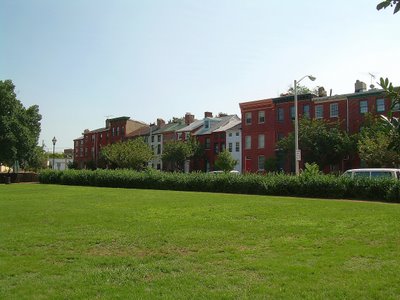
There are many possible solutions. The important point is to recognize the issues and the fact that Seton Hill does not have to remain how it is just because it has been that way for as long as anyone can remember. Seton Hill is a fantastic neighborhood, and it is time for it to have the stage so it can put on a world class performance to let everyone know.
(BUT MOST PEOPLE DON'T KNOW IT.)

Aren't you getting tired of various things being declared "Baltimore's best kept secret"? They're not secrets, they're ignorance. It's an act of pathetic desperation when ignorance is declared a virtue in the name of reverse psychology, or some kind of fake snob appeal exclusivity, or out of some strange fear that publicizing goodness will ruin it.
Take Seton Hill. It is a fantastic neighborhood, built around a huge park that most people would (figuratively) die for. It's closer to downtown than most of Fells Point and Federal Hill, and there's no physical reason why it should be perceived separately from Mount Vernon.
Most of the houses are small and manageable enough to suit modern needs, but there are a few Victorian monsters for those who are into that sort of thing. After all, why should suburban McMansion mavens have all the fun?
The iconic view of Seton Hill should be something resembling the photo above - viewing the huge grassy St. Mary's Park under mature shade trees in the foreground, and lovely nineteenth century rowhouses in the background. But who gets to take in this gorgeous view? Hardly anyone, even though it is totally public.
Even people who live in Seton Hill have to work to get that view even though it is at the center of the neighborhood. The park has a wall and hedges surrounding it, cutting it off from casual contact. There are openings in the perimeter, and ritual joggers and dog walkers can plan their day around that, but such choreographed activity is hardly casual.

There are bad rituals that lead folks to the park as well as good ones. The City has concluded that the bad ones are more likely to take place at night. So the park entrances are posted: "Park Closed From Dusk to Dawn" (picture above). It is deemed better to close up the park completely half the time than to accommodate these bad people.
The traffic patterns in Seton Hill are truly bizarre. There is very little possible neighborhood vehicular circulation. One must plan one's entry route to the neighborhood based on where on wishes to attempt to park. If one wishes to try to park on the long block of Paca Street adjacent to the park (shown in Picture 1), it is advisable to enter the neighborhood from the south from Franklin Street, even if you're actually coming from the north. If you want to park on Orchard or St. Mary, you pretty much have to enter the neighborhood on Druid Hill Avenue via MLK Boulevard from the north, even if you are actually coming from the south.
This does not mean that Seton Hill is sheltered from heavy through traffic. Quite the contrary. Paca is the heaviest northbound street on downtown's entire west side. Eutaw is the ONLY through street that serves southbound traffic between Cathedral/Maryland and Greene/Pennsylvania, a distance of five blocks or more. Which is particularly odd since all the other streets are one-way northbound while Eutaw is two-way and has only a single southbound thru lane. Druid Hill, McCulloh, Madison and Centre are also thru traffic conduits.
The circulation in the triangular portion of Seton Hill inside MLK Boulevard, Druid Hill Avenue and Eutaw Street defies description. Inside this "Bermuda Triangle" are by far the most disastrously designed intersections in the urban city. They were probably designed at the same time back in the '60's or so, and probably represent the nadir of urban traffic planning.
 The intersection of McCulloh, Madison and Orchard is shown in the picture above. McCulloh has a very tight, sharp angled yield/ merge/ weave with Madison, which aside from being a disaster for pedestrians, is terrible for motor vehicles too because much of the traffic coming from Madison to the right wants to bear left into MLK, while much of the McCulloh traffic from the left wants to bear right to avoid the turn into MLK. The only way to make these quasi-expressway maneuvers work at all is to cut off Orchard Street altogether, so it has an ugly cul-de-sac, which leads to the circuitous circulation for which the explanation was previously attempted.
The intersection of McCulloh, Madison and Orchard is shown in the picture above. McCulloh has a very tight, sharp angled yield/ merge/ weave with Madison, which aside from being a disaster for pedestrians, is terrible for motor vehicles too because much of the traffic coming from Madison to the right wants to bear left into MLK, while much of the McCulloh traffic from the left wants to bear right to avoid the turn into MLK. The only way to make these quasi-expressway maneuvers work at all is to cut off Orchard Street altogether, so it has an ugly cul-de-sac, which leads to the circuitous circulation for which the explanation was previously attempted.Orchard should be the street that provides the direct physical and emotional connection between Seton Hill and Mount Vernon, but because of the cul-de-sac and the extremely hostile intersection for pedestrians, this does not exist.

If anything, the intersection a short block away at Madison, Eutaw and Paca is even more bizarre. The picture above looks east on Madison Street, which is one-way westbound. Paca is just to the right. Most of the traffic on Paca wishes to proceed onto northbound Eutaw, which is to the left in front of the monster parking garage. The only way to do this is to engage in a slalom that requires turning right the wrong way on the one-way Madison for a short distance and then left onto Eutaw. This slalom involves two lanes of traffic, although during most hours there is only one lane on northbound Eutaw to accept this traffic. There are no warnings about the need to merge into one lane, and any attempt to provide such a warning would simply divert the motorists' attention away from the myriad other hazards, such as pedestrians and vehicles illegally turning right on red. Similarly, there is no warning on Madison about the traffic from Paca which suddenly appears going the wrong way down a one-way street.
To further confuse matters, the combined intersection of these streets is physically huge and unchannelized, with extremely large turning radii, especially for the right turn from Madison to Eutaw (which is prohibited on red.)
In sum, Seton Hill has the most schizophrenic traffic patterns in all of Baltimore.
The underlying blame for this condition can probably be traced to the fact that Seton Hill is located at the point of collision between the north-south street grid of downtown and the angled street grid of northwest Baltimore. Paca, Eutaw, Centre and Madison Streets represent the former, while St. Mary, Orchard, McCulloh and Druid Hill represent the latter.
But blaming Seton Hill's problems on a 19th century accident of geographical fate is the pinnacle of lame excuses, and merely illustrates just how ridiculous urban inertia (urbinertia?) can be. With regard to Seton Hill, the City needs to face the following:
1. St. Mary's Park needs to function like virtually all great urban parks - it needs to be at the center of EVERYTHING. It needs to function as a town square; as the central stage on which all the urban theater which is Seton Hill is played out.
2. Seton Hill needs to be integrated into adjacent Mount Vernon, which is currently experiencing a neighborhood renaissance simply because it has found its identity. Mount Vernon finally knows what it is and is acting accordingly to do something about it.
There is still a tendency to get hung up over geometric shapes and configurations. St. Mary's Park has spent most of its life not as a park but as the grounds of St. Mary's Seminary. Many Baltimore parks are not parks because they were planned that way from the beginning, but simply because they were bequeathed to the City by the landowners. Similarly, intersections need to function and it is sometimes difficult for traffic engineers to make intersections work if they are carrying traffic on more than two streets.
But enough with the excuses. Mount Vernon Square is called a square NOT because it is in the shape of a square (which it isn't), but because it is the central stage for Mount Vernon as a neighborhood. Here's what needs to be done:
1. A public street needs to be built through St. Mary's Park between St. Mary and Paca Street. That's right - right thru it. It will not carry much traffic and it can be very narrow, but it will make St. Mary's Park function as a true public space and it will orient that space to the neighborhood as a whole. Seton Hill residents will be able to use the street to circle around the neighborhood as they search for that holy grail of urban neighborhoods - a parking space. People who live on St. Mary and Orchard will finally thus finally feel a physical bond with people who live on Paca. Park dwellers will no longer be tempted to behave as if they are in a private space, but will feel like they are on the urban stage. This will feed the healthy need for urban neighborhoods to accommodate exhibitionists and their audience. Moreover, the police will be able to cruise around the neighborhood and watch the park denizens from their vehicles. There should thus no longer be a need to shut the park down at sundown.
2. The intersections on Madison Street at Eutaw/Paca and Orchard/McCulloh need to be reconfigured into normal urban intersections instead of weird satanic death traps. Madison Street needs to serve as the spine that unifies Mount Vernon and Seton Hill. To do this properly, the appropriate traffic functions need to be defined for Paca, Eutaw, McCulloh and Druid Hill. A proposal that was made for the Upton Master Plan (the neighborhood to the north) was to connect Paca to Madison Avenue to the northwest to eliminate Paca's deathly connections to northbound Eutaw and McCulloh, which hurt not only Seton Hill but Upton as well. Excess thru traffic can also be diverted from Druid Hill Avenue, although this would require adjustments outside Seton Hill. As always, thru traffic planning requires a broad perspective.

There are many possible solutions. The important point is to recognize the issues and the fact that Seton Hill does not have to remain how it is just because it has been that way for as long as anyone can remember. Seton Hill is a fantastic neighborhood, and it is time for it to have the stage so it can put on a world class performance to let everyone know.
As usual, great post. I worked in real estate in the city for 10 years, and only once had a client interested in Seton Hill. They didn't buy anything, but the main thing I remember is what a pain it was to get around, I could never get to the house on the first try but ended up driving around every time. The houses were nice and the neighborhood seemed good, I don't think I even realized what a nice park they have. It's definitely a neighborhood that flies under the radar screen-
ReplyDeleteMine is one of the houses that you can see in your first picture. You're right, Seton Hill is a fantastic neighborhood and the traffic patterns are totally bizarre. HOWEVER - the idea of bringing a street through St. Mary's Park would not solve anything. Many neighbors use the park to let their dogs run free and their children run around. Bringing traffic would eliminate the playground feel of the park and undermine the hard work of the neighbors who have made great strides in making the park a community gathering point. It may not function as a "stage," but it does function as a quiet, wide-open green space that the community does use. Among its other charms, Seton Hill is very friendly and would welcome people from other neighborhoods who want to use the park, but its earlier history as a monastary has evolved into a feeling of a retreat from the madness of the city - a feeling that is hard to get anywhere else so close to downtown. For theater, we go to Mt. Vernon. For peace and reflection, and to run our dogs and let our children play without fear of traffic, we go to St. Mary's Park. The police currently do use the park as a way to connect the East and West sides of the park in their patrols, and unlike most downtown neighborhoods, Seton Hill residents don't generally have to prowl for parking.
ReplyDeleteThere is an effort to increase the link with Mt. Vernon, but the community has a character very distinct from that of our neighbor, and that should be preserved.
Thanks for the comments. I'm glad Anonymous #2 is comfortable with the obscurity of his neighborhood and park. I'm sure no expert on the issues of kids and dogs running around unleashed, but if it works for all, that's great. As a real estate agent, Anonymous #1 sees a bit more of a problem in Seton Hill's obscurity. In any event, I can't see how Seton Hill could ever lose its distinct community character.
ReplyDeletethe dogs make it a little safer, or atleast keep the drug boys away
ReplyDelete